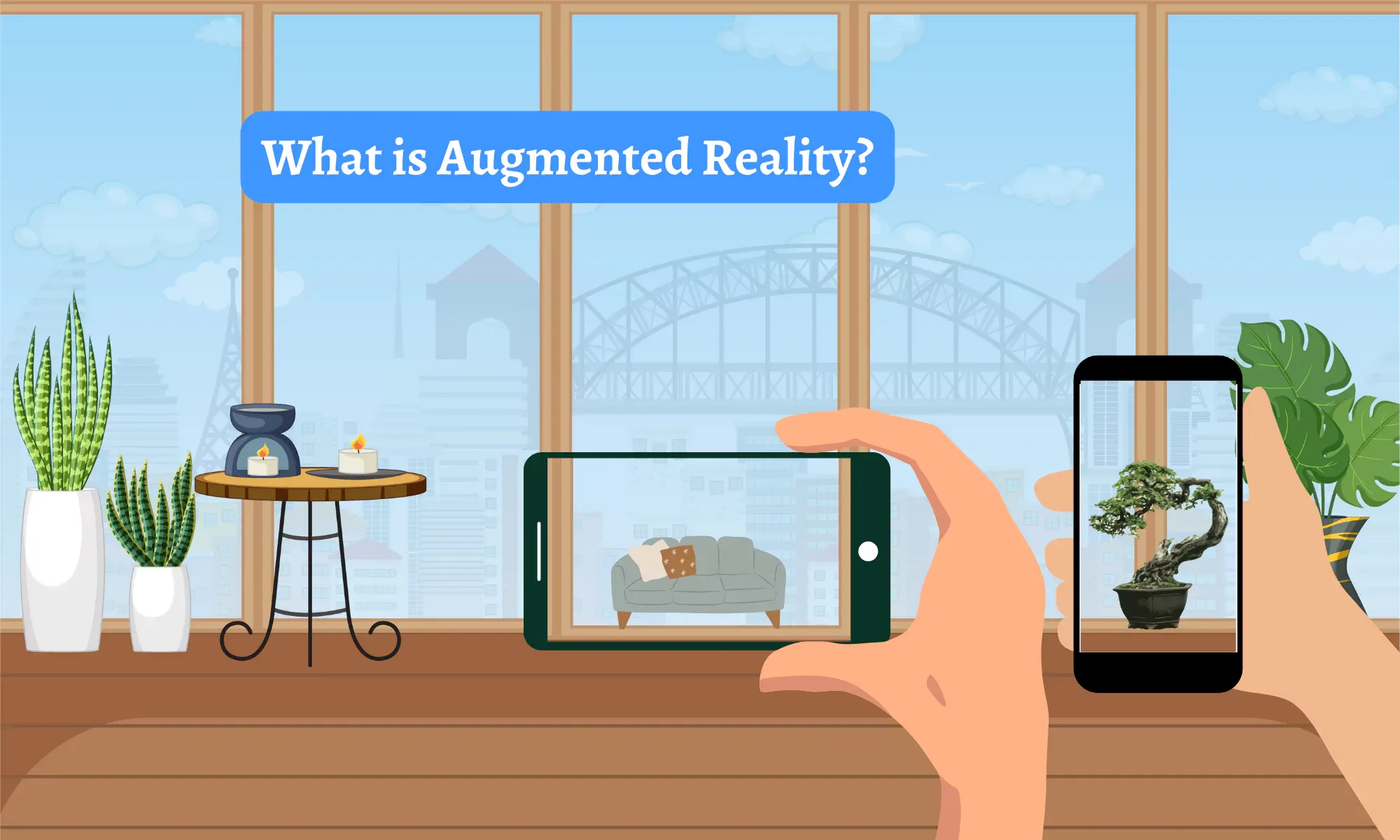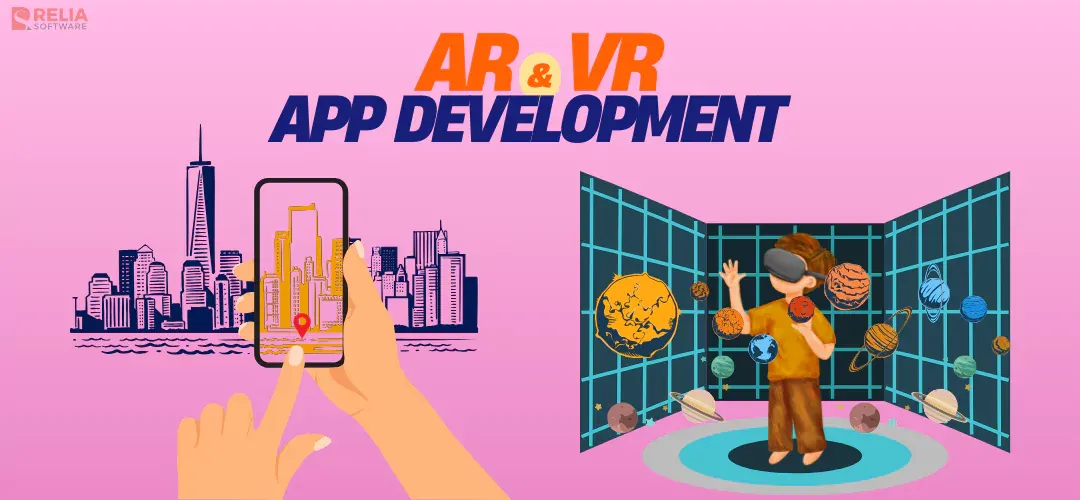Augmented reality (AR) and virtual reality (VR) are fast changing how we use technology. AR & VR are being used by companies across industries to improve consumer experiences, streamline processes, and generate new goods and services. However, is it worth investing in an AR/VR app?
This article will explain in detail the AR/VR app development process, its benefits, expenses, and concerns. It can help you choose the appropriate AR/VR app development for your business, whether you want to improve consumer engagement or training.
What is Augmented Reality (AR)?
Augmented reality (AR) is a technology that applies computer-generated content to the actual environment. This material can be visual, aural, or touchable. It keeps users grounded in the actual world while supplementing it with digital information.
Imagine pointing your phone at a landmark and watching an AR (augmented reality) overlay show you how it was built or who lived there. AR can also display driving directions directly on your car windshield. Furthermore, it can help building furniture just got easier. AR can show you step-by-step instructions directly on the furniture itself.
AR technology uses sensors like cameras and motion detectors to help AR understand your environment. This lets it place digital objects perfectly, creating a smooth blend of real and virtual worlds.

What is Virtual Reality (VR)?
VR creates a whole new computer world to simulate reality, while AR adds digital elements to our real world. Wearing a headset blocks out your surroundings and lets you see and interact with virtual environments. And motion tracking lets you move around naturally.
Users can virtually visit anywhere – Mars, Mount Everest, and even swim with dolphins. It's great for learning where students can explore historical sites or witness events firsthand. Even professionals like pilots, surgeons, and firefighters can train safely in VR simulations.

Understanding the Differences Between AR and VR
Augmented reality (AR) and virtual reality (VR) are two technologies that blur the distinction between real and digital worlds but they offer different experiences The following is a discussion of the important distinctions to help you determine which technology may be best for your needs:
Real Versus Virtual Environments
AR helps users stay grounded in the actual world. It overlays digital information on what you see through your phone or special glasses. On the other hand, VR entirely replaces the physical world. You will wear VR headsets, which block your surroundings and immerse you in a completely computer-generated environment.
Focus and Interaction
AR technology enables users to engage with digital elements while remaining focused on the actual environment. It's great for tasks where you need to stay aware of your surroundings, like assembling furniture or finding your way around a new place.
Meanwhile, VR provides a whole new world to explore! You'll feel like you're in a different world, making it perfect for simulations, training, and games.
Accessibility and Cost
AR technology is typically more affordable and accessible. You can experience AR with just a smartphone or tablet, no fancy gear is needed. While VR technology is getting cheaper, but the headsets can still be expensive.
Applications
AR adds digital layers to the real world, like showing furniture assembly steps or historic landmarks in detail. Meanwhile, VR creates entirely new, immersive computer worlds for games, training simulations, or exploring exotic locations.
Therefore, AR is used in education (interactive learning), marketing (product visualization), retail (virtual try-on), manufacturing (assembly guides), and healthcare (medical training). While, VR shines in entertainment (gaming), training (aviation, surgery), and design (architecture walkthroughs, product prototypes).
Here is a table comparison to help you distinguish these two types of reality developments easily:
| Feature | Augmented Reality (AR) | Virtual Reality (VR) |
Environment | Overlays digital elements onto the real world | Creates a completely simulated environment |
Focus & Interaction | Users maintain focus on the real world, interacting with digital elements | Users are fully immersed and interact with the virtual environment |
Accessibility & Cost | More accessible, often accessed through smartphones/tablets | Requires specialized headsets, generally more expensive |
Applications | Education, marketing, retail, manufacturing, healthcare | Entertainment (gaming), training (aviation, surgery), design (architecture, product development) |
User Awareness | Users remain aware of their physical surroundings | Users lose awareness of their physical surroundings |
The AR/VR App Development Process
Step 1: Define Your App Idea
The first stage is to specify the goal and functionality of your AR/VR app. What problem will your app solve or what experience will it create? Who are you building it for? Answering these questions first will make development smoother and ensure your app is valuable.
For example, here are some app concepts to consider:
- AR for Furniture Shopping: An AR app that lets furniture shoppers virtually place furniture in their homes before buying (problem-solving for furniture companies).
- VR Museum Tour: A VR museum app could take visitors on virtual tours of historical sites or let them walk with dinosaurs (educational for museums).
- VR Adventure Game: A VR game could immerse players in a magical underwater world (entertainment for gamers).
Step 2: Choose Your Development Platform
There are several AR/VR development platforms available; each has its unique strengths and disadvantages. Consider aspects such as the platform's learning curve, compatibility with your chosen hardware, and functionality to determine the best fit for your project.
Some development platforms include:
- Unity: Unity, a popular choice for both new and experienced developers, has an easy-to-use interface and a large library of assets and tools for developing AR and VR experiences.
- Unreal Engine: This powerful engine is renowned for its outstanding visuals and is frequently utilized in high-end VR games. However, it has a steeper learning curve than Unity.
- ARKit: If you're creating an AR app, particularly for Apple devices, ARKit is an excellent choice because it is tightly integrated with the iOS operating system.
- ARCore: Similarly, ARCore is Google's foundation for creating augmented reality experiences on Android smartphones.
>> Read more:
- Cross-Platform App Development: Top 5 Best Frameworks
- 8 Best Android App Development Frameworks For Developers & Businesses
- Top 9 Machine Learning Platforms for Developers
Step 3: Design and Development
During this stage, you will create your app's visual elements and capabilities. Collaboration among designers, developers, and potentially 3D artists is required to produce a unified and compelling user experience. This includes:
- 3D Modelling for VR Environments: When developing VR apps, you must design 3D models of the virtual worlds that users will explore. This could range from designing structures and landscapes to creating personalities and items.
- Designing User Interfaces (UIs): Both AR and VR apps require user-friendly UIs that enable interaction with the experience. In AR, UIs may be presented on the user's smartphone screen, whereas VR UIs may be embedded into the virtual environment.
- Engineering the App's Logic and Interactions: The basic functionality of your app is brought to life through programming. This entails writing code to specify how users interact with AR/VR features, how things behave, and how the whole experience plays out.
>> Read more:
Step 4: Testing and Deployment
Thorough testing is necessary to ensure that your AR/VR software runs properly and provides a great experience. Testing should include a variety of devices and contexts to find and correct any faults or issues. Once testing is completed, you can publish your app in the relevant app store (iOS or Android) for consumers to download and use.
Some aspects that could be tested:
- Compatibility Testing: Depending on the selected platform, you should confirm that your software works properly on a variety of VR headsets or smartphone types.
- Performance Testing: To provide a flawless user experience, evaluate the app's performance in terms of smoothness, frame rate, and potential lag.
- Usability Testing: Watch people engage with your app to find any areas where the UI is unclear or the interactions are not intuitive.
>> Read more:
- Software Testing Life Cycle (STLC)
- 4 Levels Of Testing In Software Testing
- Detailed Explanation of 7 Software Testing Principles
The Cost of AR/VR App Development
The cost of developing your mobile app varies according to its requirements, timeline, and complexity. Creating a mobile AR/VR application with a proprietary algorithm and API will also cost more. Normally, an AR app typically costs between $10,000 and $100,000, while VR app can cost from $30,000 to over $150,000.
By Complexity
| Complexity | Cost | |
| AR Apps | Simple App | $10,000 - $50,000 |
| Medium Complex App | $50,000 - $100,000 | |
| High Complex App | $100,000+ | |
| VR Apps | Simple App | $30,000 - $85,000+ |
| Medium Complex App | $85,000 - $150,000+ | |
| High Complex App | $150,000+ | |
By Region
| Region | Cost per hour |
| North America | $150 to $275 |
| South America | $45 to $150 |
| Western Europe | $35 and $170 |
| Central Europe | $22 to $160 |
| Asia | $10 to $120 |
>> Read more: Detailed Breakdown For App Development Cost
Benefits of AR/VR Apps Development for Businesses
In today's competitive market, organizations seek new ways to engage customers, improve training, and optimize operations. AR/VR app development is a strong option with several benefits:
- Improved Customer Experiences: Imagine tourists taking VR tours or furniture shoppers placing virtual furniture at home. AR/VR creates a more engaging and satisfying customer experience, leading to higher satisfaction and brand loyalty.
- Improved Training and Education: Train staff safely with simulated scenarios in AR/VR. This is useful for healthcare, manufacturing, and aviation. Students can virtually visit historical sites or conduct experiments with AR, enhancing learning.
- Increased Sales and Marketing: Promote products in VR or let customers virtually try things on with AR. This interactive approach can increase brand awareness, sales, and engagement.
- Streamlined Design and Prototyping: Use AR/VR to create 3D models and prototypes. This improves collaboration, visualization, and early problem detection, reducing design and development costs.
- Remote Collaboration and Communication: Teams worldwide can work together on projects in real time using VR. Imagine architects using VR to virtually walk through building designs together. This improves communication, workflow, and productivity.
- Better Data Visualisation and Analytics: Visualize complex data interactively with AR/VR. This helps businesses see trends, gain insights, and make data-driven decisions for better performance.
>> Read more: A Comprehensive Guide to Software Development Outsourcing
The Future Of AR/VR App Development
AR/VR app development is ready for a major leap ahead, propelled by a combination of technological advancements and user adoption. According to Statista, the worldwide AR/VR market will be worth $300 billion by 2025, indicating a significant increase in demand. Here's what's driving that growth:
- VR Headset Advancements: VR headsets are becoming lighter, cheaper, and sharper (IDC), making VR more accessible. VR headset shipments are predicted to surpass 50 million by 2024, indicating a larger user base.
- Easier access to AR: Smartphones and tablets are making AR experiences more accessible to everyone, removing the need for special gear (ISACA study). With 70% of consumers feeling that AR has benefits, widespread adoption appears imminent.
- Artificial Intelligence (AI) and Machine Learning Integration: Understanding and responding to users is critical to the success of AR/VR applications. AI and machine learning will personalize experiences and make these apps more valuable (Gartner expects that 40% of large firms will adopt AI-powered AR/VR by 2025).
These trends, together with the increased demand for immersive experiences, indicate a promising future for AR/VR app development. As technology advances and becomes more accessible, expect even more imaginative applications across a variety of industries.
Conclusion
Integrating AR and VR app developments paves the door for a bright future in mobile application development for your business. If you want to create an AR or VR app for your organization, you should work with a mobile app development company that specializes in these technologies. Their counsel can assist you in developing a user-friendly, engaging app that is in line with your business objectives.
>>> Follow and Contact Relia Software for more information!
- Mobile App Development
- development

